Nike Global Business Analysis
VerifiedAdded on 2020/09/08
|12
|3895
|233
Case Study
AI Summary
This case study analyzes Nike's global business environment, focusing on key factors such as cost, market dynamics, and competition. It discusses the strategic challenges Nike faces in international operations, including relocation issues, competition in the apparel industry, and ethical concerns. The study evaluates the impact of globalization on Nike's governance, leadership, and organizational structure, as well as the company's commitment to ethical and sustainable practices. Various routes to internationalization are also explored, highlighting the barriers and strategies Nike can adopt to enhance its global presence.

Nike global business
1
1
Paraphrase This Document
Need a fresh take? Get an instant paraphrase of this document with our AI Paraphraser
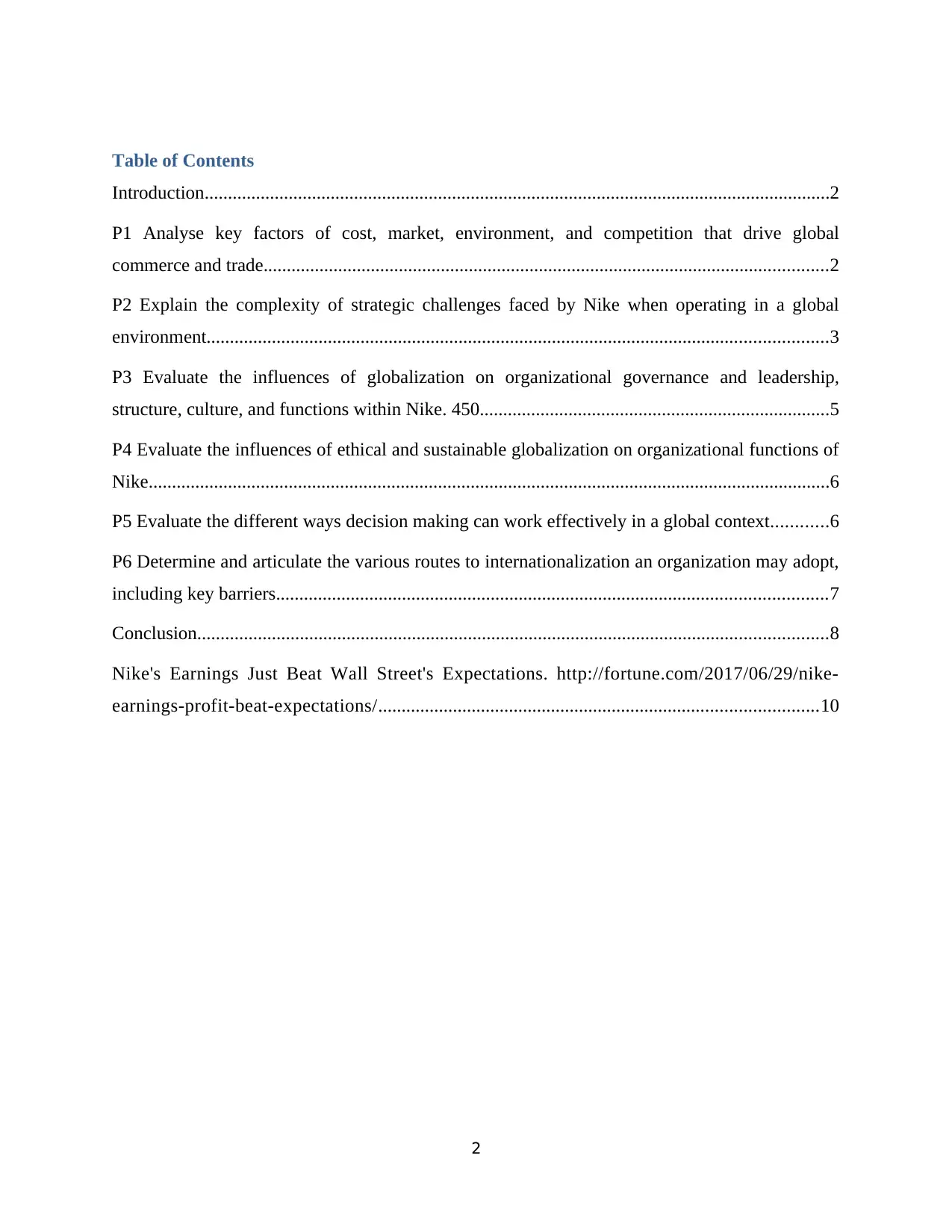
Table of Contents
Introduction......................................................................................................................................2
P1 Analyse key factors of cost, market, environment, and competition that drive global
commerce and trade.........................................................................................................................2
P2 Explain the complexity of strategic challenges faced by Nike when operating in a global
environment.....................................................................................................................................3
P3 Evaluate the influences of globalization on organizational governance and leadership,
structure, culture, and functions within Nike. 450...........................................................................5
P4 Evaluate the influences of ethical and sustainable globalization on organizational functions of
Nike..................................................................................................................................................6
P5 Evaluate the different ways decision making can work effectively in a global context............6
P6 Determine and articulate the various routes to internationalization an organization may adopt,
including key barriers......................................................................................................................7
Conclusion.......................................................................................................................................8
Nike's Earnings Just Beat Wall Street's Expectations. http://fortune.com/2017/06/29/nike-
earnings-profit-beat-expectations/..............................................................................................10
2
Introduction......................................................................................................................................2
P1 Analyse key factors of cost, market, environment, and competition that drive global
commerce and trade.........................................................................................................................2
P2 Explain the complexity of strategic challenges faced by Nike when operating in a global
environment.....................................................................................................................................3
P3 Evaluate the influences of globalization on organizational governance and leadership,
structure, culture, and functions within Nike. 450...........................................................................5
P4 Evaluate the influences of ethical and sustainable globalization on organizational functions of
Nike..................................................................................................................................................6
P5 Evaluate the different ways decision making can work effectively in a global context............6
P6 Determine and articulate the various routes to internationalization an organization may adopt,
including key barriers......................................................................................................................7
Conclusion.......................................................................................................................................8
Nike's Earnings Just Beat Wall Street's Expectations. http://fortune.com/2017/06/29/nike-
earnings-profit-beat-expectations/..............................................................................................10
2
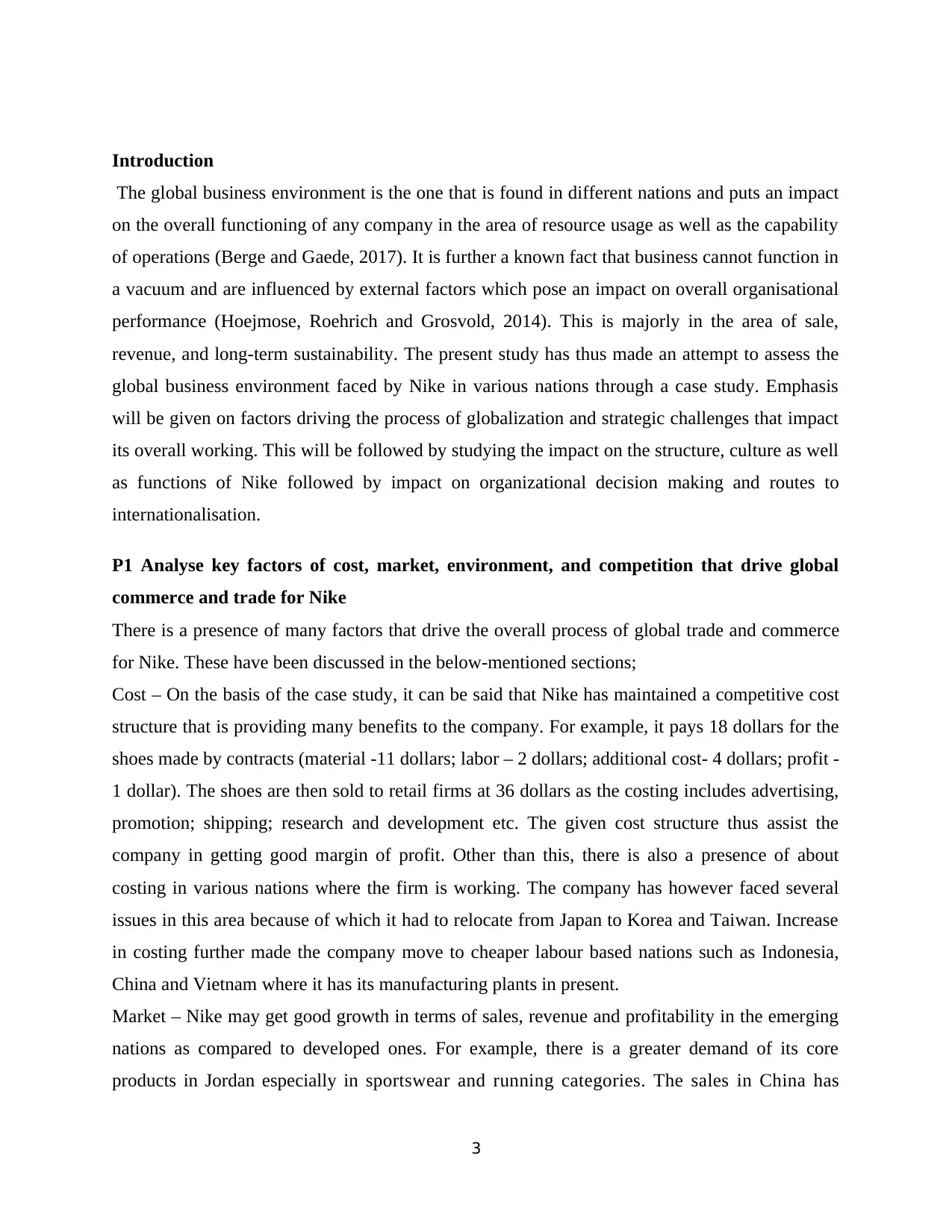
Introduction
The global business environment is the one that is found in different nations and puts an impact
on the overall functioning of any company in the area of resource usage as well as the capability
of operations (Berge and Gaede, 2017). It is further a known fact that business cannot function in
a vacuum and are influenced by external factors which pose an impact on overall organisational
performance (Hoejmose, Roehrich and Grosvold, 2014). This is majorly in the area of sale,
revenue, and long-term sustainability. The present study has thus made an attempt to assess the
global business environment faced by Nike in various nations through a case study. Emphasis
will be given on factors driving the process of globalization and strategic challenges that impact
its overall working. This will be followed by studying the impact on the structure, culture as well
as functions of Nike followed by impact on organizational decision making and routes to
internationalisation.
P1 Analyse key factors of cost, market, environment, and competition that drive global
commerce and trade for Nike
There is a presence of many factors that drive the overall process of global trade and commerce
for Nike. These have been discussed in the below-mentioned sections;
Cost – On the basis of the case study, it can be said that Nike has maintained a competitive cost
structure that is providing many benefits to the company. For example, it pays 18 dollars for the
shoes made by contracts (material -11 dollars; labor – 2 dollars; additional cost- 4 dollars; profit -
1 dollar). The shoes are then sold to retail firms at 36 dollars as the costing includes advertising,
promotion; shipping; research and development etc. The given cost structure thus assist the
company in getting good margin of profit. Other than this, there is also a presence of about
costing in various nations where the firm is working. The company has however faced several
issues in this area because of which it had to relocate from Japan to Korea and Taiwan. Increase
in costing further made the company move to cheaper labour based nations such as Indonesia,
China and Vietnam where it has its manufacturing plants in present.
Market – Nike may get good growth in terms of sales, revenue and profitability in the emerging
nations as compared to developed ones. For example, there is a greater demand of its core
products in Jordan especially in sportswear and running categories. The sales in China has
3
The global business environment is the one that is found in different nations and puts an impact
on the overall functioning of any company in the area of resource usage as well as the capability
of operations (Berge and Gaede, 2017). It is further a known fact that business cannot function in
a vacuum and are influenced by external factors which pose an impact on overall organisational
performance (Hoejmose, Roehrich and Grosvold, 2014). This is majorly in the area of sale,
revenue, and long-term sustainability. The present study has thus made an attempt to assess the
global business environment faced by Nike in various nations through a case study. Emphasis
will be given on factors driving the process of globalization and strategic challenges that impact
its overall working. This will be followed by studying the impact on the structure, culture as well
as functions of Nike followed by impact on organizational decision making and routes to
internationalisation.
P1 Analyse key factors of cost, market, environment, and competition that drive global
commerce and trade for Nike
There is a presence of many factors that drive the overall process of global trade and commerce
for Nike. These have been discussed in the below-mentioned sections;
Cost – On the basis of the case study, it can be said that Nike has maintained a competitive cost
structure that is providing many benefits to the company. For example, it pays 18 dollars for the
shoes made by contracts (material -11 dollars; labor – 2 dollars; additional cost- 4 dollars; profit -
1 dollar). The shoes are then sold to retail firms at 36 dollars as the costing includes advertising,
promotion; shipping; research and development etc. The given cost structure thus assist the
company in getting good margin of profit. Other than this, there is also a presence of about
costing in various nations where the firm is working. The company has however faced several
issues in this area because of which it had to relocate from Japan to Korea and Taiwan. Increase
in costing further made the company move to cheaper labour based nations such as Indonesia,
China and Vietnam where it has its manufacturing plants in present.
Market – Nike may get good growth in terms of sales, revenue and profitability in the emerging
nations as compared to developed ones. For example, there is a greater demand of its core
products in Jordan especially in sportswear and running categories. The sales in China has
3
⊘ This is a preview!⊘
Do you want full access?
Subscribe today to unlock all pages.

Trusted by 1+ million students worldwide
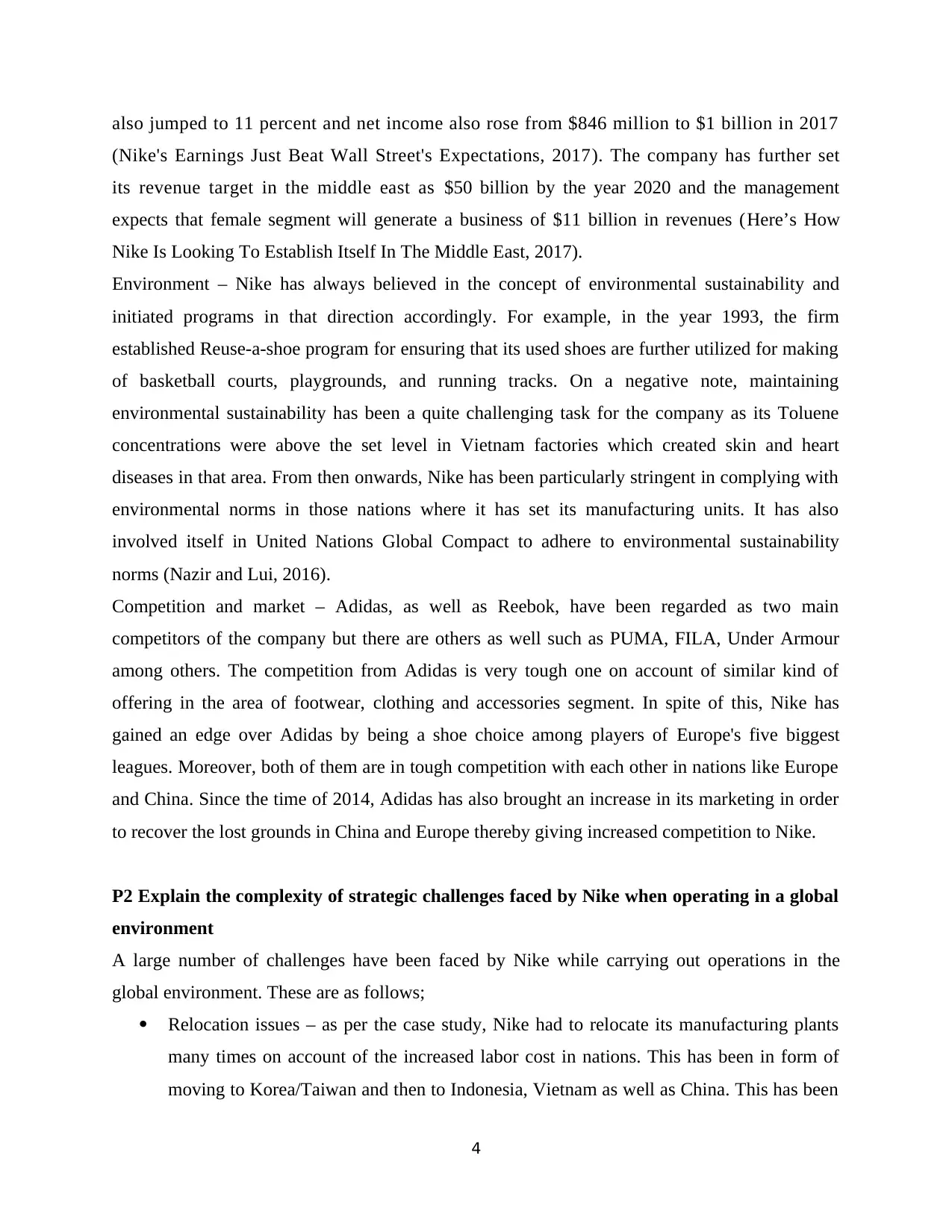
also jumped to 11 percent and net income also rose from $846 million to $1 billion in 2017
(Nike's Earnings Just Beat Wall Street's Expectations, 2017). The company has further set
its revenue target in the middle east as $50 billion by the year 2020 and the management
expects that female segment will generate a business of $11 billion in revenues (Here’s How
Nike Is Looking To Establish Itself In The Middle East, 2017).
Environment – Nike has always believed in the concept of environmental sustainability and
initiated programs in that direction accordingly. For example, in the year 1993, the firm
established Reuse-a-shoe program for ensuring that its used shoes are further utilized for making
of basketball courts, playgrounds, and running tracks. On a negative note, maintaining
environmental sustainability has been a quite challenging task for the company as its Toluene
concentrations were above the set level in Vietnam factories which created skin and heart
diseases in that area. From then onwards, Nike has been particularly stringent in complying with
environmental norms in those nations where it has set its manufacturing units. It has also
involved itself in United Nations Global Compact to adhere to environmental sustainability
norms (Nazir and Lui, 2016).
Competition and market – Adidas, as well as Reebok, have been regarded as two main
competitors of the company but there are others as well such as PUMA, FILA, Under Armour
among others. The competition from Adidas is very tough one on account of similar kind of
offering in the area of footwear, clothing and accessories segment. In spite of this, Nike has
gained an edge over Adidas by being a shoe choice among players of Europe's five biggest
leagues. Moreover, both of them are in tough competition with each other in nations like Europe
and China. Since the time of 2014, Adidas has also brought an increase in its marketing in order
to recover the lost grounds in China and Europe thereby giving increased competition to Nike.
P2 Explain the complexity of strategic challenges faced by Nike when operating in a global
environment
A large number of challenges have been faced by Nike while carrying out operations in the
global environment. These are as follows;
Relocation issues – as per the case study, Nike had to relocate its manufacturing plants
many times on account of the increased labor cost in nations. This has been in form of
moving to Korea/Taiwan and then to Indonesia, Vietnam as well as China. This has been
4
(Nike's Earnings Just Beat Wall Street's Expectations, 2017). The company has further set
its revenue target in the middle east as $50 billion by the year 2020 and the management
expects that female segment will generate a business of $11 billion in revenues (Here’s How
Nike Is Looking To Establish Itself In The Middle East, 2017).
Environment – Nike has always believed in the concept of environmental sustainability and
initiated programs in that direction accordingly. For example, in the year 1993, the firm
established Reuse-a-shoe program for ensuring that its used shoes are further utilized for making
of basketball courts, playgrounds, and running tracks. On a negative note, maintaining
environmental sustainability has been a quite challenging task for the company as its Toluene
concentrations were above the set level in Vietnam factories which created skin and heart
diseases in that area. From then onwards, Nike has been particularly stringent in complying with
environmental norms in those nations where it has set its manufacturing units. It has also
involved itself in United Nations Global Compact to adhere to environmental sustainability
norms (Nazir and Lui, 2016).
Competition and market – Adidas, as well as Reebok, have been regarded as two main
competitors of the company but there are others as well such as PUMA, FILA, Under Armour
among others. The competition from Adidas is very tough one on account of similar kind of
offering in the area of footwear, clothing and accessories segment. In spite of this, Nike has
gained an edge over Adidas by being a shoe choice among players of Europe's five biggest
leagues. Moreover, both of them are in tough competition with each other in nations like Europe
and China. Since the time of 2014, Adidas has also brought an increase in its marketing in order
to recover the lost grounds in China and Europe thereby giving increased competition to Nike.
P2 Explain the complexity of strategic challenges faced by Nike when operating in a global
environment
A large number of challenges have been faced by Nike while carrying out operations in the
global environment. These are as follows;
Relocation issues – as per the case study, Nike had to relocate its manufacturing plants
many times on account of the increased labor cost in nations. This has been in form of
moving to Korea/Taiwan and then to Indonesia, Vietnam as well as China. This has been
4
Paraphrase This Document
Need a fresh take? Get an instant paraphrase of this document with our AI Paraphraser
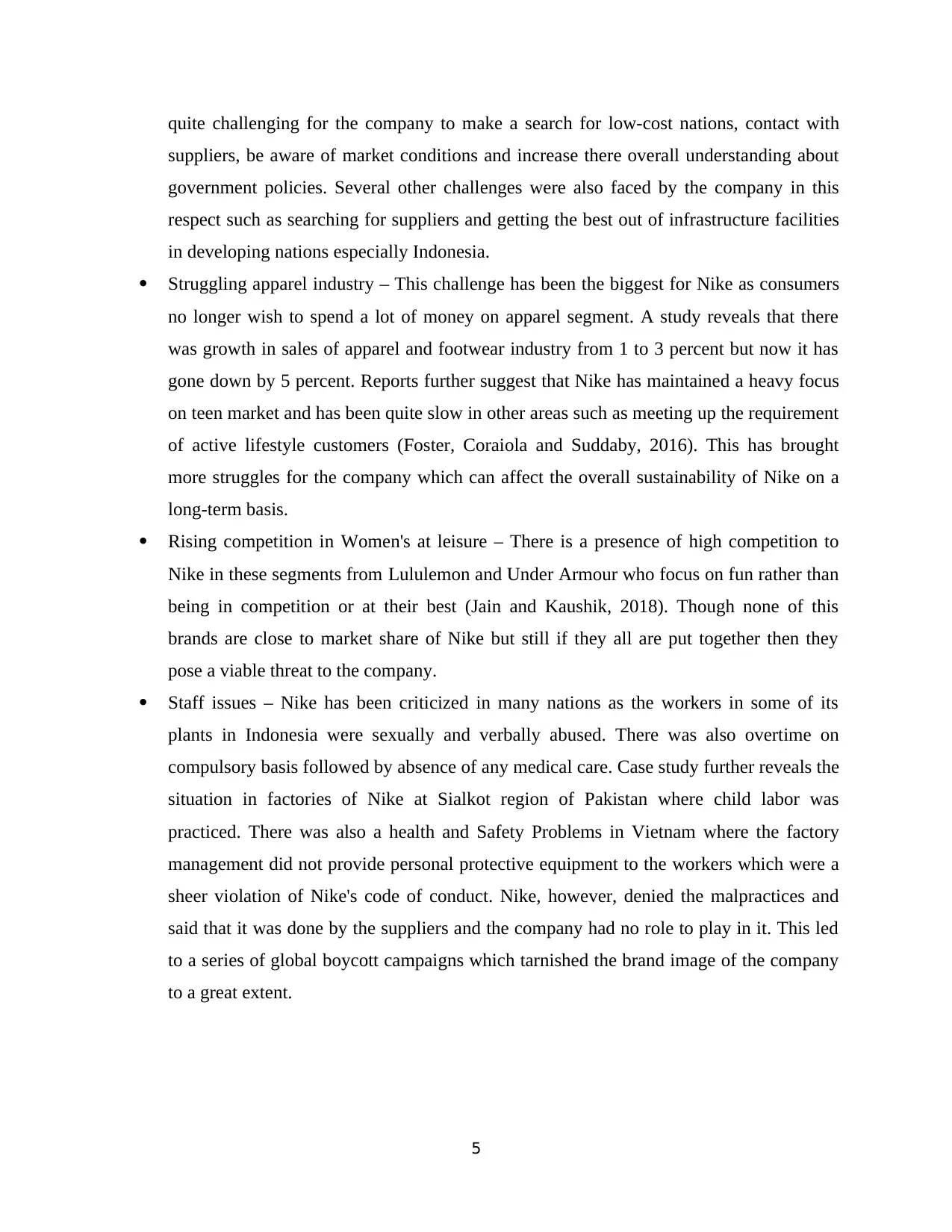
quite challenging for the company to make a search for low-cost nations, contact with
suppliers, be aware of market conditions and increase there overall understanding about
government policies. Several other challenges were also faced by the company in this
respect such as searching for suppliers and getting the best out of infrastructure facilities
in developing nations especially Indonesia.
Struggling apparel industry – This challenge has been the biggest for Nike as consumers
no longer wish to spend a lot of money on apparel segment. A study reveals that there
was growth in sales of apparel and footwear industry from 1 to 3 percent but now it has
gone down by 5 percent. Reports further suggest that Nike has maintained a heavy focus
on teen market and has been quite slow in other areas such as meeting up the requirement
of active lifestyle customers (Foster, Coraiola and Suddaby, 2016). This has brought
more struggles for the company which can affect the overall sustainability of Nike on a
long-term basis.
Rising competition in Women's at leisure – There is a presence of high competition to
Nike in these segments from Lululemon and Under Armour who focus on fun rather than
being in competition or at their best (Jain and Kaushik, 2018). Though none of this
brands are close to market share of Nike but still if they all are put together then they
pose a viable threat to the company.
Staff issues – Nike has been criticized in many nations as the workers in some of its
plants in Indonesia were sexually and verbally abused. There was also overtime on
compulsory basis followed by absence of any medical care. Case study further reveals the
situation in factories of Nike at Sialkot region of Pakistan where child labor was
practiced. There was also a health and Safety Problems in Vietnam where the factory
management did not provide personal protective equipment to the workers which were a
sheer violation of Nike's code of conduct. Nike, however, denied the malpractices and
said that it was done by the suppliers and the company had no role to play in it. This led
to a series of global boycott campaigns which tarnished the brand image of the company
to a great extent.
5
suppliers, be aware of market conditions and increase there overall understanding about
government policies. Several other challenges were also faced by the company in this
respect such as searching for suppliers and getting the best out of infrastructure facilities
in developing nations especially Indonesia.
Struggling apparel industry – This challenge has been the biggest for Nike as consumers
no longer wish to spend a lot of money on apparel segment. A study reveals that there
was growth in sales of apparel and footwear industry from 1 to 3 percent but now it has
gone down by 5 percent. Reports further suggest that Nike has maintained a heavy focus
on teen market and has been quite slow in other areas such as meeting up the requirement
of active lifestyle customers (Foster, Coraiola and Suddaby, 2016). This has brought
more struggles for the company which can affect the overall sustainability of Nike on a
long-term basis.
Rising competition in Women's at leisure – There is a presence of high competition to
Nike in these segments from Lululemon and Under Armour who focus on fun rather than
being in competition or at their best (Jain and Kaushik, 2018). Though none of this
brands are close to market share of Nike but still if they all are put together then they
pose a viable threat to the company.
Staff issues – Nike has been criticized in many nations as the workers in some of its
plants in Indonesia were sexually and verbally abused. There was also overtime on
compulsory basis followed by absence of any medical care. Case study further reveals the
situation in factories of Nike at Sialkot region of Pakistan where child labor was
practiced. There was also a health and Safety Problems in Vietnam where the factory
management did not provide personal protective equipment to the workers which were a
sheer violation of Nike's code of conduct. Nike, however, denied the malpractices and
said that it was done by the suppliers and the company had no role to play in it. This led
to a series of global boycott campaigns which tarnished the brand image of the company
to a great extent.
5
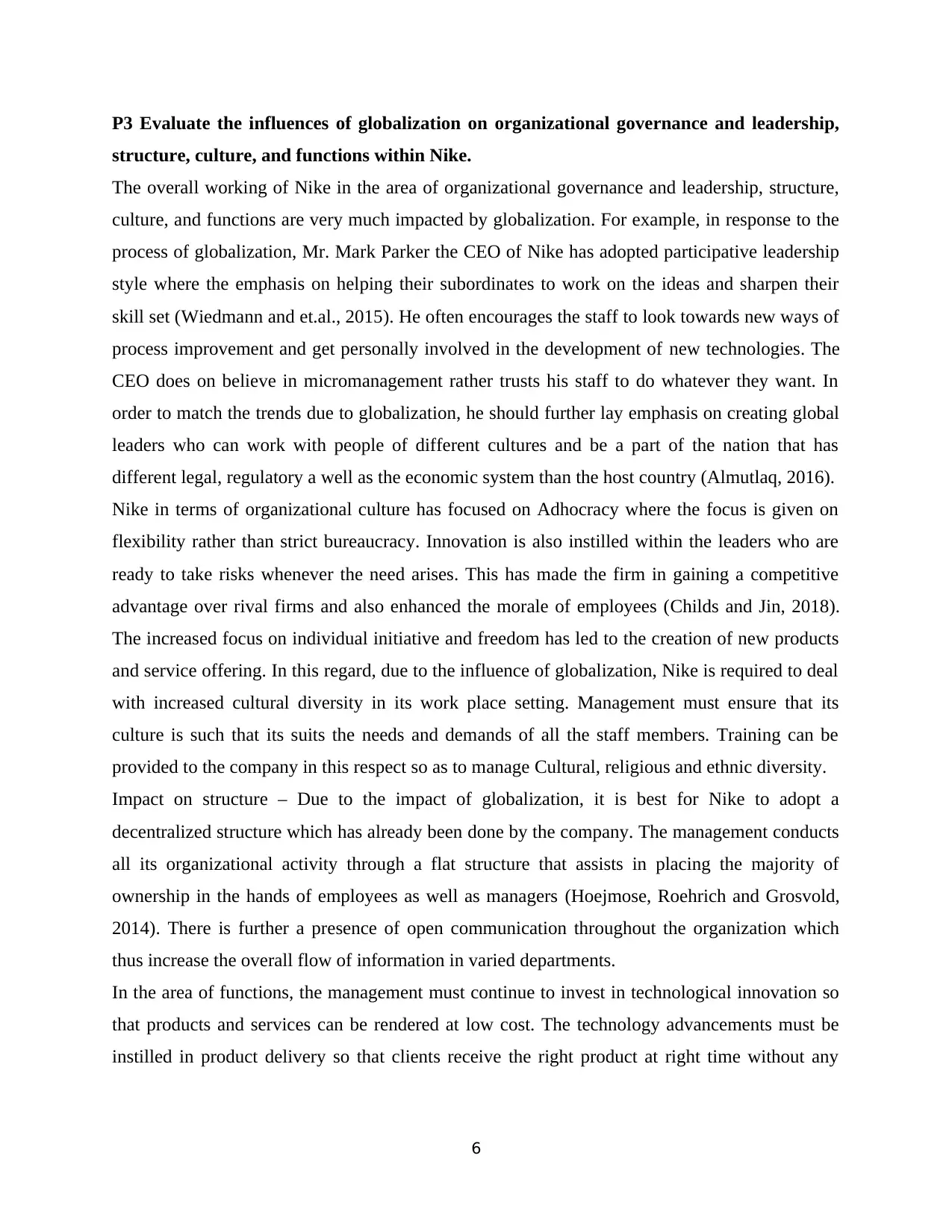
P3 Evaluate the influences of globalization on organizational governance and leadership,
structure, culture, and functions within Nike.
The overall working of Nike in the area of organizational governance and leadership, structure,
culture, and functions are very much impacted by globalization. For example, in response to the
process of globalization, Mr. Mark Parker the CEO of Nike has adopted participative leadership
style where the emphasis on helping their subordinates to work on the ideas and sharpen their
skill set (Wiedmann and et.al., 2015). He often encourages the staff to look towards new ways of
process improvement and get personally involved in the development of new technologies. The
CEO does on believe in micromanagement rather trusts his staff to do whatever they want. In
order to match the trends due to globalization, he should further lay emphasis on creating global
leaders who can work with people of different cultures and be a part of the nation that has
different legal, regulatory a well as the economic system than the host country (Almutlaq, 2016).
Nike in terms of organizational culture has focused on Adhocracy where the focus is given on
flexibility rather than strict bureaucracy. Innovation is also instilled within the leaders who are
ready to take risks whenever the need arises. This has made the firm in gaining a competitive
advantage over rival firms and also enhanced the morale of employees (Childs and Jin, 2018).
The increased focus on individual initiative and freedom has led to the creation of new products
and service offering. In this regard, due to the influence of globalization, Nike is required to deal
with increased cultural diversity in its work place setting. Management must ensure that its
culture is such that its suits the needs and demands of all the staff members. Training can be
provided to the company in this respect so as to manage Cultural, religious and ethnic diversity.
Impact on structure – Due to the impact of globalization, it is best for Nike to adopt a
decentralized structure which has already been done by the company. The management conducts
all its organizational activity through a flat structure that assists in placing the majority of
ownership in the hands of employees as well as managers (Hoejmose, Roehrich and Grosvold,
2014). There is further a presence of open communication throughout the organization which
thus increase the overall flow of information in varied departments.
In the area of functions, the management must continue to invest in technological innovation so
that products and services can be rendered at low cost. The technology advancements must be
instilled in product delivery so that clients receive the right product at right time without any
6
structure, culture, and functions within Nike.
The overall working of Nike in the area of organizational governance and leadership, structure,
culture, and functions are very much impacted by globalization. For example, in response to the
process of globalization, Mr. Mark Parker the CEO of Nike has adopted participative leadership
style where the emphasis on helping their subordinates to work on the ideas and sharpen their
skill set (Wiedmann and et.al., 2015). He often encourages the staff to look towards new ways of
process improvement and get personally involved in the development of new technologies. The
CEO does on believe in micromanagement rather trusts his staff to do whatever they want. In
order to match the trends due to globalization, he should further lay emphasis on creating global
leaders who can work with people of different cultures and be a part of the nation that has
different legal, regulatory a well as the economic system than the host country (Almutlaq, 2016).
Nike in terms of organizational culture has focused on Adhocracy where the focus is given on
flexibility rather than strict bureaucracy. Innovation is also instilled within the leaders who are
ready to take risks whenever the need arises. This has made the firm in gaining a competitive
advantage over rival firms and also enhanced the morale of employees (Childs and Jin, 2018).
The increased focus on individual initiative and freedom has led to the creation of new products
and service offering. In this regard, due to the influence of globalization, Nike is required to deal
with increased cultural diversity in its work place setting. Management must ensure that its
culture is such that its suits the needs and demands of all the staff members. Training can be
provided to the company in this respect so as to manage Cultural, religious and ethnic diversity.
Impact on structure – Due to the impact of globalization, it is best for Nike to adopt a
decentralized structure which has already been done by the company. The management conducts
all its organizational activity through a flat structure that assists in placing the majority of
ownership in the hands of employees as well as managers (Hoejmose, Roehrich and Grosvold,
2014). There is further a presence of open communication throughout the organization which
thus increase the overall flow of information in varied departments.
In the area of functions, the management must continue to invest in technological innovation so
that products and services can be rendered at low cost. The technology advancements must be
instilled in product delivery so that clients receive the right product at right time without any
6
⊘ This is a preview!⊘
Do you want full access?
Subscribe today to unlock all pages.

Trusted by 1+ million students worldwide
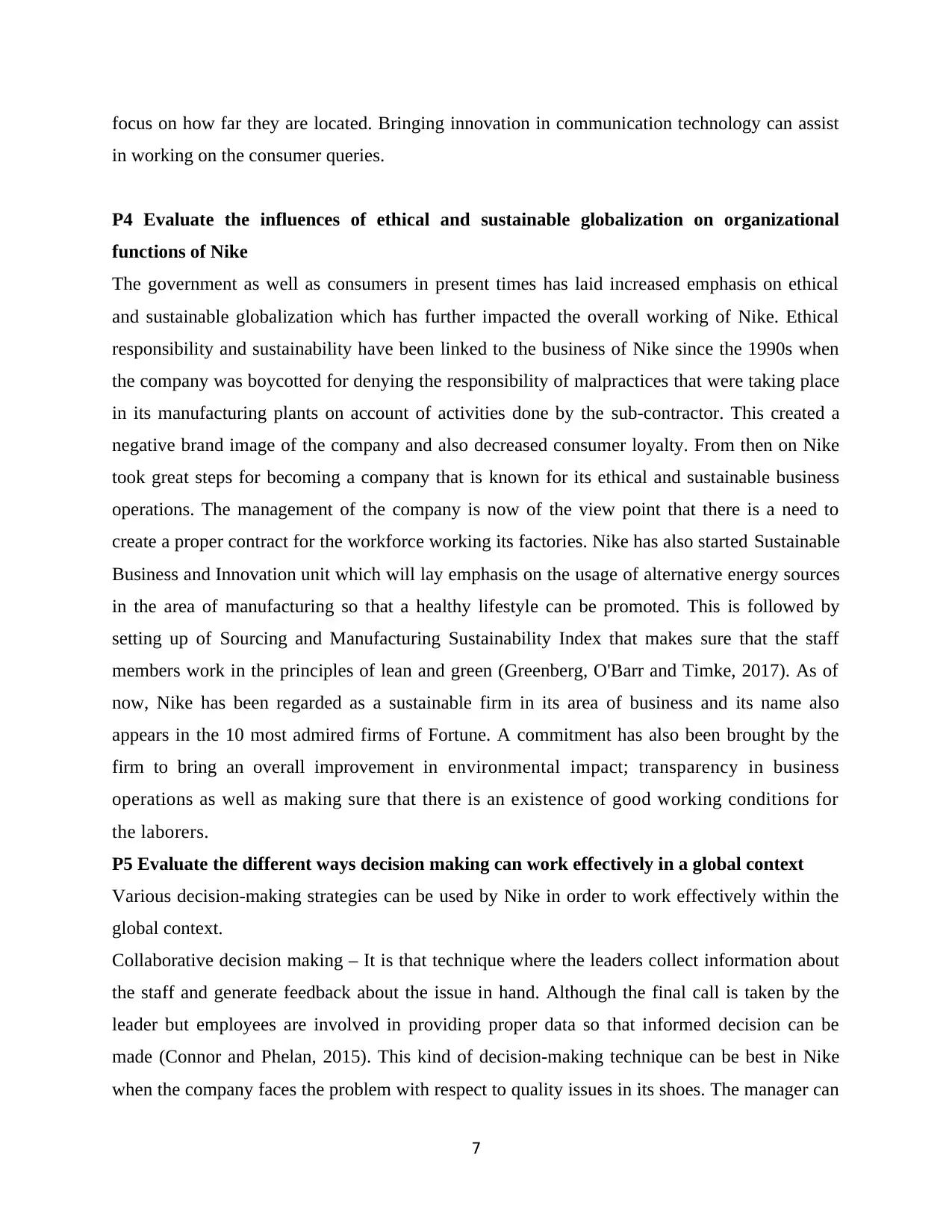
focus on how far they are located. Bringing innovation in communication technology can assist
in working on the consumer queries.
P4 Evaluate the influences of ethical and sustainable globalization on organizational
functions of Nike
The government as well as consumers in present times has laid increased emphasis on ethical
and sustainable globalization which has further impacted the overall working of Nike. Ethical
responsibility and sustainability have been linked to the business of Nike since the 1990s when
the company was boycotted for denying the responsibility of malpractices that were taking place
in its manufacturing plants on account of activities done by the sub-contractor. This created a
negative brand image of the company and also decreased consumer loyalty. From then on Nike
took great steps for becoming a company that is known for its ethical and sustainable business
operations. The management of the company is now of the view point that there is a need to
create a proper contract for the workforce working its factories. Nike has also started Sustainable
Business and Innovation unit which will lay emphasis on the usage of alternative energy sources
in the area of manufacturing so that a healthy lifestyle can be promoted. This is followed by
setting up of Sourcing and Manufacturing Sustainability Index that makes sure that the staff
members work in the principles of lean and green (Greenberg, O'Barr and Timke, 2017). As of
now, Nike has been regarded as a sustainable firm in its area of business and its name also
appears in the 10 most admired firms of Fortune. A commitment has also been brought by the
firm to bring an overall improvement in environmental impact; transparency in business
operations as well as making sure that there is an existence of good working conditions for
the laborers.
P5 Evaluate the different ways decision making can work effectively in a global context
Various decision-making strategies can be used by Nike in order to work effectively within the
global context.
Collaborative decision making – It is that technique where the leaders collect information about
the staff and generate feedback about the issue in hand. Although the final call is taken by the
leader but employees are involved in providing proper data so that informed decision can be
made (Connor and Phelan, 2015). This kind of decision-making technique can be best in Nike
when the company faces the problem with respect to quality issues in its shoes. The manager can
7
in working on the consumer queries.
P4 Evaluate the influences of ethical and sustainable globalization on organizational
functions of Nike
The government as well as consumers in present times has laid increased emphasis on ethical
and sustainable globalization which has further impacted the overall working of Nike. Ethical
responsibility and sustainability have been linked to the business of Nike since the 1990s when
the company was boycotted for denying the responsibility of malpractices that were taking place
in its manufacturing plants on account of activities done by the sub-contractor. This created a
negative brand image of the company and also decreased consumer loyalty. From then on Nike
took great steps for becoming a company that is known for its ethical and sustainable business
operations. The management of the company is now of the view point that there is a need to
create a proper contract for the workforce working its factories. Nike has also started Sustainable
Business and Innovation unit which will lay emphasis on the usage of alternative energy sources
in the area of manufacturing so that a healthy lifestyle can be promoted. This is followed by
setting up of Sourcing and Manufacturing Sustainability Index that makes sure that the staff
members work in the principles of lean and green (Greenberg, O'Barr and Timke, 2017). As of
now, Nike has been regarded as a sustainable firm in its area of business and its name also
appears in the 10 most admired firms of Fortune. A commitment has also been brought by the
firm to bring an overall improvement in environmental impact; transparency in business
operations as well as making sure that there is an existence of good working conditions for
the laborers.
P5 Evaluate the different ways decision making can work effectively in a global context
Various decision-making strategies can be used by Nike in order to work effectively within the
global context.
Collaborative decision making – It is that technique where the leaders collect information about
the staff and generate feedback about the issue in hand. Although the final call is taken by the
leader but employees are involved in providing proper data so that informed decision can be
made (Connor and Phelan, 2015). This kind of decision-making technique can be best in Nike
when the company faces the problem with respect to quality issues in its shoes. The manager can
7
Paraphrase This Document
Need a fresh take? Get an instant paraphrase of this document with our AI Paraphraser
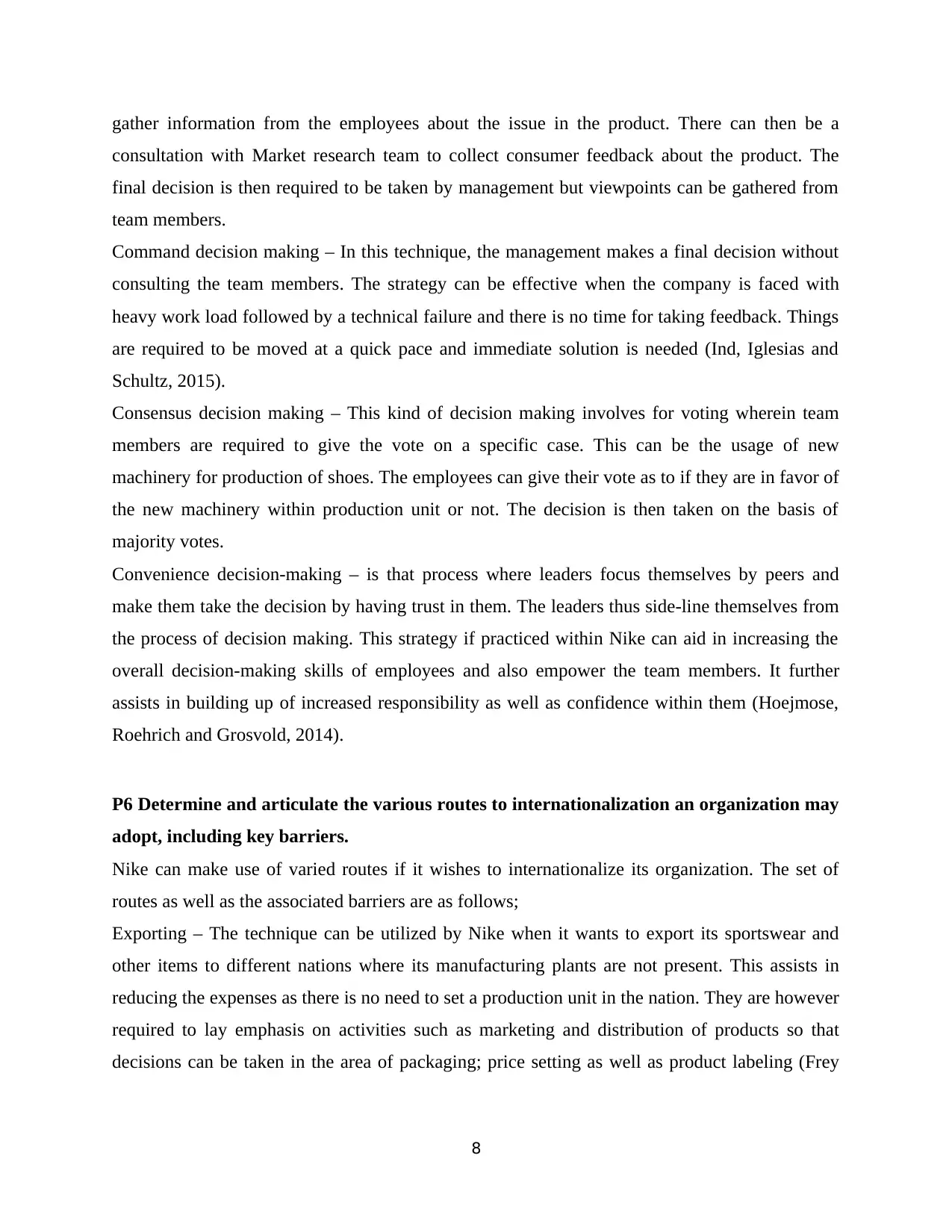
gather information from the employees about the issue in the product. There can then be a
consultation with Market research team to collect consumer feedback about the product. The
final decision is then required to be taken by management but viewpoints can be gathered from
team members.
Command decision making – In this technique, the management makes a final decision without
consulting the team members. The strategy can be effective when the company is faced with
heavy work load followed by a technical failure and there is no time for taking feedback. Things
are required to be moved at a quick pace and immediate solution is needed (Ind, Iglesias and
Schultz, 2015).
Consensus decision making – This kind of decision making involves for voting wherein team
members are required to give the vote on a specific case. This can be the usage of new
machinery for production of shoes. The employees can give their vote as to if they are in favor of
the new machinery within production unit or not. The decision is then taken on the basis of
majority votes.
Convenience decision-making – is that process where leaders focus themselves by peers and
make them take the decision by having trust in them. The leaders thus side-line themselves from
the process of decision making. This strategy if practiced within Nike can aid in increasing the
overall decision-making skills of employees and also empower the team members. It further
assists in building up of increased responsibility as well as confidence within them (Hoejmose,
Roehrich and Grosvold, 2014).
P6 Determine and articulate the various routes to internationalization an organization may
adopt, including key barriers.
Nike can make use of varied routes if it wishes to internationalize its organization. The set of
routes as well as the associated barriers are as follows;
Exporting – The technique can be utilized by Nike when it wants to export its sportswear and
other items to different nations where its manufacturing plants are not present. This assists in
reducing the expenses as there is no need to set a production unit in the nation. They are however
required to lay emphasis on activities such as marketing and distribution of products so that
decisions can be taken in the area of packaging; price setting as well as product labeling (Frey
8
consultation with Market research team to collect consumer feedback about the product. The
final decision is then required to be taken by management but viewpoints can be gathered from
team members.
Command decision making – In this technique, the management makes a final decision without
consulting the team members. The strategy can be effective when the company is faced with
heavy work load followed by a technical failure and there is no time for taking feedback. Things
are required to be moved at a quick pace and immediate solution is needed (Ind, Iglesias and
Schultz, 2015).
Consensus decision making – This kind of decision making involves for voting wherein team
members are required to give the vote on a specific case. This can be the usage of new
machinery for production of shoes. The employees can give their vote as to if they are in favor of
the new machinery within production unit or not. The decision is then taken on the basis of
majority votes.
Convenience decision-making – is that process where leaders focus themselves by peers and
make them take the decision by having trust in them. The leaders thus side-line themselves from
the process of decision making. This strategy if practiced within Nike can aid in increasing the
overall decision-making skills of employees and also empower the team members. It further
assists in building up of increased responsibility as well as confidence within them (Hoejmose,
Roehrich and Grosvold, 2014).
P6 Determine and articulate the various routes to internationalization an organization may
adopt, including key barriers.
Nike can make use of varied routes if it wishes to internationalize its organization. The set of
routes as well as the associated barriers are as follows;
Exporting – The technique can be utilized by Nike when it wants to export its sportswear and
other items to different nations where its manufacturing plants are not present. This assists in
reducing the expenses as there is no need to set a production unit in the nation. They are however
required to lay emphasis on activities such as marketing and distribution of products so that
decisions can be taken in the area of packaging; price setting as well as product labeling (Frey
8
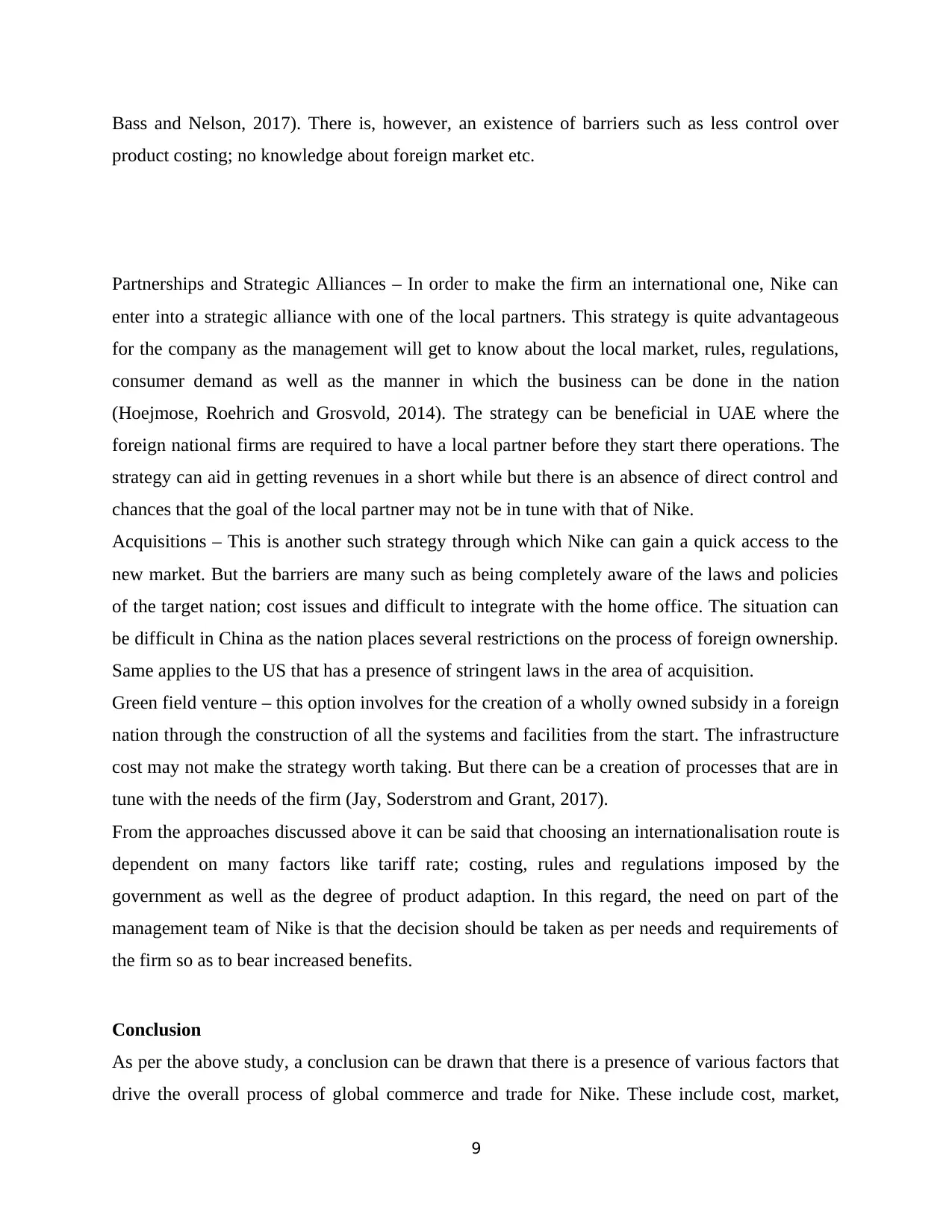
Bass and Nelson, 2017). There is, however, an existence of barriers such as less control over
product costing; no knowledge about foreign market etc.
Partnerships and Strategic Alliances – In order to make the firm an international one, Nike can
enter into a strategic alliance with one of the local partners. This strategy is quite advantageous
for the company as the management will get to know about the local market, rules, regulations,
consumer demand as well as the manner in which the business can be done in the nation
(Hoejmose, Roehrich and Grosvold, 2014). The strategy can be beneficial in UAE where the
foreign national firms are required to have a local partner before they start there operations. The
strategy can aid in getting revenues in a short while but there is an absence of direct control and
chances that the goal of the local partner may not be in tune with that of Nike.
Acquisitions – This is another such strategy through which Nike can gain a quick access to the
new market. But the barriers are many such as being completely aware of the laws and policies
of the target nation; cost issues and difficult to integrate with the home office. The situation can
be difficult in China as the nation places several restrictions on the process of foreign ownership.
Same applies to the US that has a presence of stringent laws in the area of acquisition.
Green field venture – this option involves for the creation of a wholly owned subsidy in a foreign
nation through the construction of all the systems and facilities from the start. The infrastructure
cost may not make the strategy worth taking. But there can be a creation of processes that are in
tune with the needs of the firm (Jay, Soderstrom and Grant, 2017).
From the approaches discussed above it can be said that choosing an internationalisation route is
dependent on many factors like tariff rate; costing, rules and regulations imposed by the
government as well as the degree of product adaption. In this regard, the need on part of the
management team of Nike is that the decision should be taken as per needs and requirements of
the firm so as to bear increased benefits.
Conclusion
As per the above study, a conclusion can be drawn that there is a presence of various factors that
drive the overall process of global commerce and trade for Nike. These include cost, market,
9
product costing; no knowledge about foreign market etc.
Partnerships and Strategic Alliances – In order to make the firm an international one, Nike can
enter into a strategic alliance with one of the local partners. This strategy is quite advantageous
for the company as the management will get to know about the local market, rules, regulations,
consumer demand as well as the manner in which the business can be done in the nation
(Hoejmose, Roehrich and Grosvold, 2014). The strategy can be beneficial in UAE where the
foreign national firms are required to have a local partner before they start there operations. The
strategy can aid in getting revenues in a short while but there is an absence of direct control and
chances that the goal of the local partner may not be in tune with that of Nike.
Acquisitions – This is another such strategy through which Nike can gain a quick access to the
new market. But the barriers are many such as being completely aware of the laws and policies
of the target nation; cost issues and difficult to integrate with the home office. The situation can
be difficult in China as the nation places several restrictions on the process of foreign ownership.
Same applies to the US that has a presence of stringent laws in the area of acquisition.
Green field venture – this option involves for the creation of a wholly owned subsidy in a foreign
nation through the construction of all the systems and facilities from the start. The infrastructure
cost may not make the strategy worth taking. But there can be a creation of processes that are in
tune with the needs of the firm (Jay, Soderstrom and Grant, 2017).
From the approaches discussed above it can be said that choosing an internationalisation route is
dependent on many factors like tariff rate; costing, rules and regulations imposed by the
government as well as the degree of product adaption. In this regard, the need on part of the
management team of Nike is that the decision should be taken as per needs and requirements of
the firm so as to bear increased benefits.
Conclusion
As per the above study, a conclusion can be drawn that there is a presence of various factors that
drive the overall process of global commerce and trade for Nike. These include cost, market,
9
⊘ This is a preview!⊘
Do you want full access?
Subscribe today to unlock all pages.

Trusted by 1+ million students worldwide
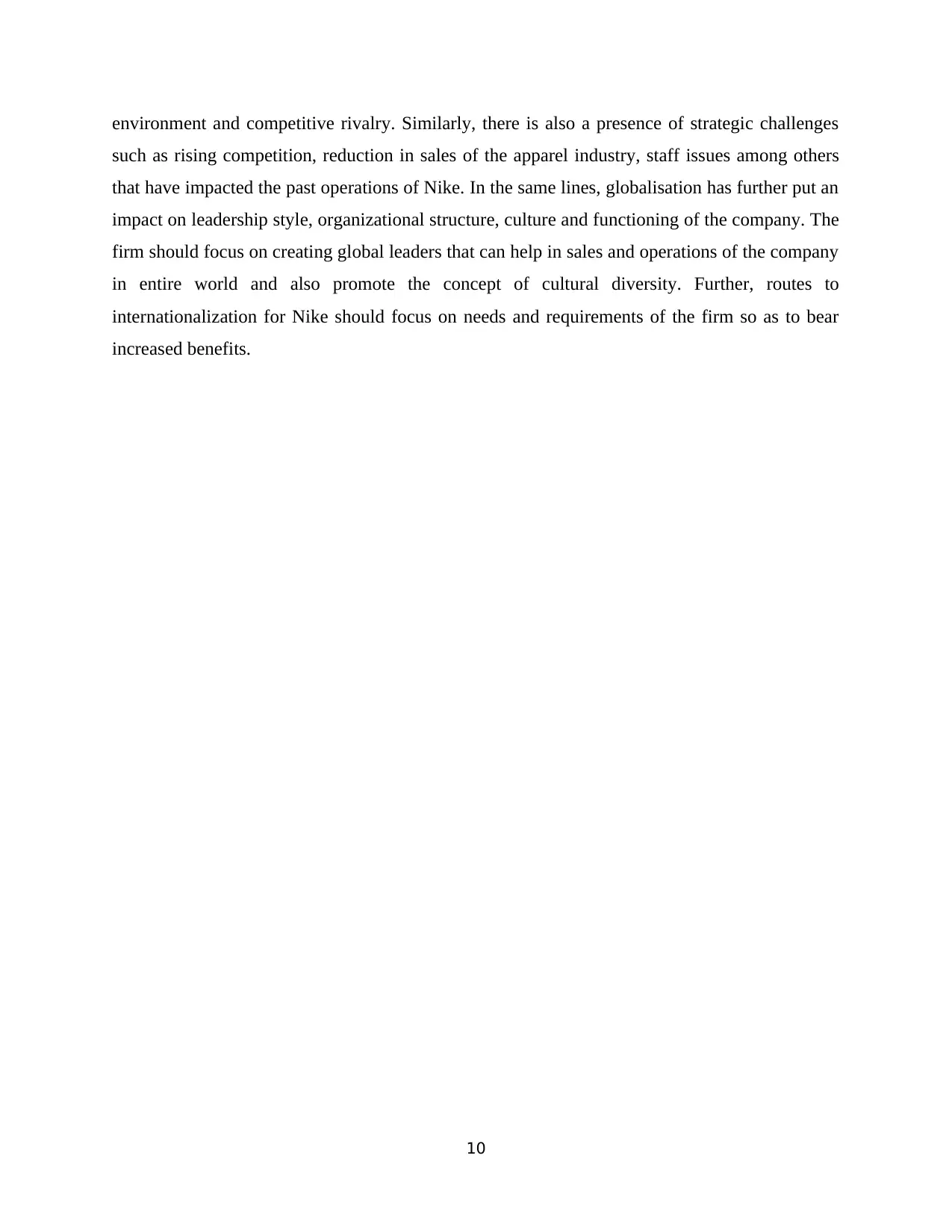
environment and competitive rivalry. Similarly, there is also a presence of strategic challenges
such as rising competition, reduction in sales of the apparel industry, staff issues among others
that have impacted the past operations of Nike. In the same lines, globalisation has further put an
impact on leadership style, organizational structure, culture and functioning of the company. The
firm should focus on creating global leaders that can help in sales and operations of the company
in entire world and also promote the concept of cultural diversity. Further, routes to
internationalization for Nike should focus on needs and requirements of the firm so as to bear
increased benefits.
10
such as rising competition, reduction in sales of the apparel industry, staff issues among others
that have impacted the past operations of Nike. In the same lines, globalisation has further put an
impact on leadership style, organizational structure, culture and functioning of the company. The
firm should focus on creating global leaders that can help in sales and operations of the company
in entire world and also promote the concept of cultural diversity. Further, routes to
internationalization for Nike should focus on needs and requirements of the firm so as to bear
increased benefits.
10
Paraphrase This Document
Need a fresh take? Get an instant paraphrase of this document with our AI Paraphraser
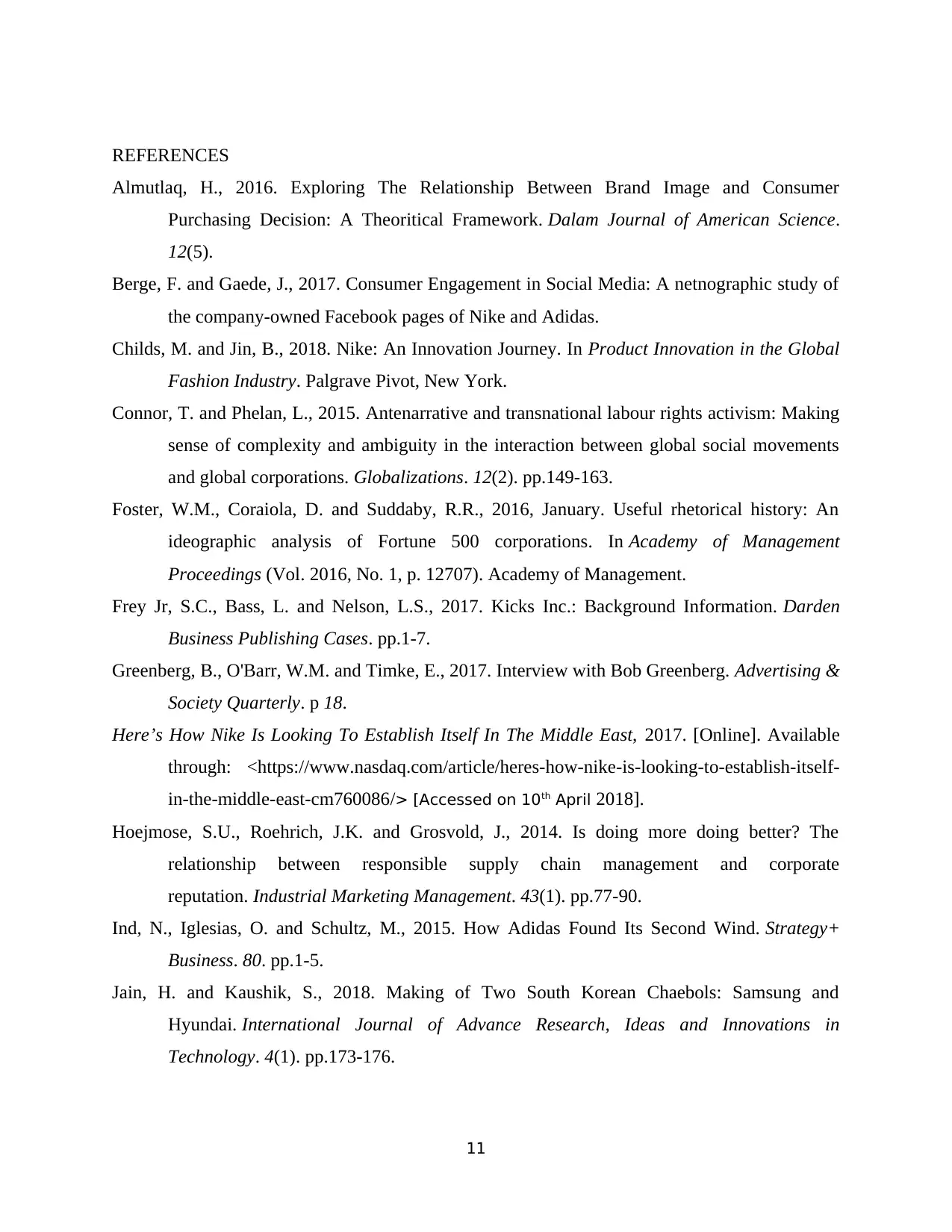
REFERENCES
Almutlaq, H., 2016. Exploring The Relationship Between Brand Image and Consumer
Purchasing Decision: A Theoritical Framework. Dalam Journal of American Science.
12(5).
Berge, F. and Gaede, J., 2017. Consumer Engagement in Social Media: A netnographic study of
the company-owned Facebook pages of Nike and Adidas.
Childs, M. and Jin, B., 2018. Nike: An Innovation Journey. In Product Innovation in the Global
Fashion Industry. Palgrave Pivot, New York.
Connor, T. and Phelan, L., 2015. Antenarrative and transnational labour rights activism: Making
sense of complexity and ambiguity in the interaction between global social movements
and global corporations. Globalizations. 12(2). pp.149-163.
Foster, W.M., Coraiola, D. and Suddaby, R.R., 2016, January. Useful rhetorical history: An
ideographic analysis of Fortune 500 corporations. In Academy of Management
Proceedings (Vol. 2016, No. 1, p. 12707). Academy of Management.
Frey Jr, S.C., Bass, L. and Nelson, L.S., 2017. Kicks Inc.: Background Information. Darden
Business Publishing Cases. pp.1-7.
Greenberg, B., O'Barr, W.M. and Timke, E., 2017. Interview with Bob Greenberg. Advertising &
Society Quarterly. p 18.
Here’s How Nike Is Looking To Establish Itself In The Middle East, 2017. [Online]. Available
through: <https://www.nasdaq.com/article/heres-how-nike-is-looking-to-establish-itself-
in-the-middle-east-cm760086/> [Accessed on 10th April 2018].
Hoejmose, S.U., Roehrich, J.K. and Grosvold, J., 2014. Is doing more doing better? The
relationship between responsible supply chain management and corporate
reputation. Industrial Marketing Management. 43(1). pp.77-90.
Ind, N., Iglesias, O. and Schultz, M., 2015. How Adidas Found Its Second Wind. Strategy+
Business. 80. pp.1-5.
Jain, H. and Kaushik, S., 2018. Making of Two South Korean Chaebols: Samsung and
Hyundai. International Journal of Advance Research, Ideas and Innovations in
Technology. 4(1). pp.173-176.
11
Almutlaq, H., 2016. Exploring The Relationship Between Brand Image and Consumer
Purchasing Decision: A Theoritical Framework. Dalam Journal of American Science.
12(5).
Berge, F. and Gaede, J., 2017. Consumer Engagement in Social Media: A netnographic study of
the company-owned Facebook pages of Nike and Adidas.
Childs, M. and Jin, B., 2018. Nike: An Innovation Journey. In Product Innovation in the Global
Fashion Industry. Palgrave Pivot, New York.
Connor, T. and Phelan, L., 2015. Antenarrative and transnational labour rights activism: Making
sense of complexity and ambiguity in the interaction between global social movements
and global corporations. Globalizations. 12(2). pp.149-163.
Foster, W.M., Coraiola, D. and Suddaby, R.R., 2016, January. Useful rhetorical history: An
ideographic analysis of Fortune 500 corporations. In Academy of Management
Proceedings (Vol. 2016, No. 1, p. 12707). Academy of Management.
Frey Jr, S.C., Bass, L. and Nelson, L.S., 2017. Kicks Inc.: Background Information. Darden
Business Publishing Cases. pp.1-7.
Greenberg, B., O'Barr, W.M. and Timke, E., 2017. Interview with Bob Greenberg. Advertising &
Society Quarterly. p 18.
Here’s How Nike Is Looking To Establish Itself In The Middle East, 2017. [Online]. Available
through: <https://www.nasdaq.com/article/heres-how-nike-is-looking-to-establish-itself-
in-the-middle-east-cm760086/> [Accessed on 10th April 2018].
Hoejmose, S.U., Roehrich, J.K. and Grosvold, J., 2014. Is doing more doing better? The
relationship between responsible supply chain management and corporate
reputation. Industrial Marketing Management. 43(1). pp.77-90.
Ind, N., Iglesias, O. and Schultz, M., 2015. How Adidas Found Its Second Wind. Strategy+
Business. 80. pp.1-5.
Jain, H. and Kaushik, S., 2018. Making of Two South Korean Chaebols: Samsung and
Hyundai. International Journal of Advance Research, Ideas and Innovations in
Technology. 4(1). pp.173-176.
11
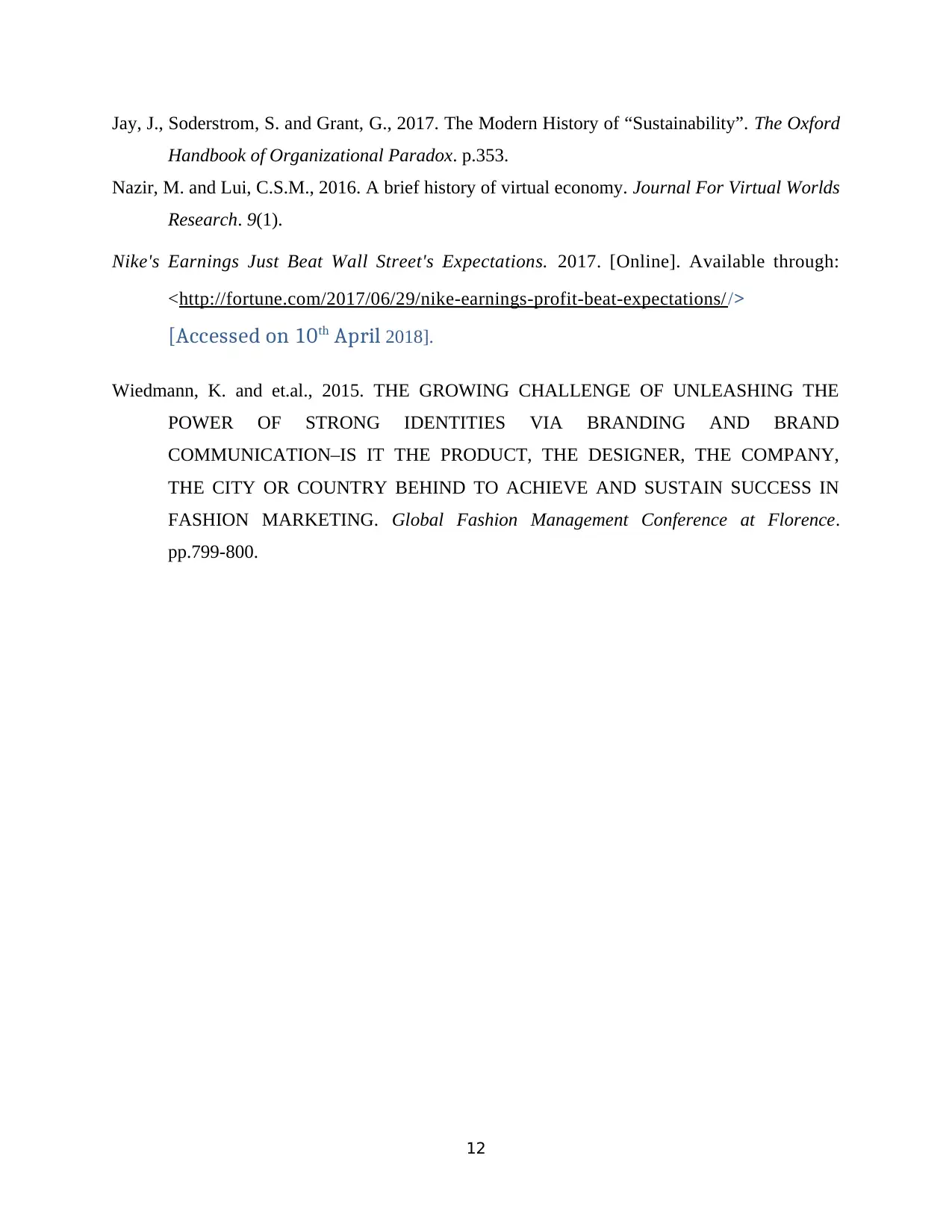
Jay, J., Soderstrom, S. and Grant, G., 2017. The Modern History of “Sustainability”. The Oxford
Handbook of Organizational Paradox. p.353.
Nazir, M. and Lui, C.S.M., 2016. A brief history of virtual economy. Journal For Virtual Worlds
Research. 9(1).
Nike's Earnings Just Beat Wall Street's Expectations. 2017. [Online]. Available through:
<http://fortune.com/2017/06/29/nike-earnings-profit-beat-expectations//>
[Accessed on 10th April 2018].
Wiedmann, K. and et.al., 2015. THE GROWING CHALLENGE OF UNLEASHING THE
POWER OF STRONG IDENTITIES VIA BRANDING AND BRAND
COMMUNICATION–IS IT THE PRODUCT, THE DESIGNER, THE COMPANY,
THE CITY OR COUNTRY BEHIND TO ACHIEVE AND SUSTAIN SUCCESS IN
FASHION MARKETING. Global Fashion Management Conference at Florence.
pp.799-800.
12
Handbook of Organizational Paradox. p.353.
Nazir, M. and Lui, C.S.M., 2016. A brief history of virtual economy. Journal For Virtual Worlds
Research. 9(1).
Nike's Earnings Just Beat Wall Street's Expectations. 2017. [Online]. Available through:
<http://fortune.com/2017/06/29/nike-earnings-profit-beat-expectations//>
[Accessed on 10th April 2018].
Wiedmann, K. and et.al., 2015. THE GROWING CHALLENGE OF UNLEASHING THE
POWER OF STRONG IDENTITIES VIA BRANDING AND BRAND
COMMUNICATION–IS IT THE PRODUCT, THE DESIGNER, THE COMPANY,
THE CITY OR COUNTRY BEHIND TO ACHIEVE AND SUSTAIN SUCCESS IN
FASHION MARKETING. Global Fashion Management Conference at Florence.
pp.799-800.
12
⊘ This is a preview!⊘
Do you want full access?
Subscribe today to unlock all pages.

Trusted by 1+ million students worldwide
1 out of 12
Related Documents
Your All-in-One AI-Powered Toolkit for Academic Success.
+13062052269
info@desklib.com
Available 24*7 on WhatsApp / Email
![[object Object]](/_next/static/media/star-bottom.7253800d.svg)
Unlock your academic potential
Copyright © 2020–2025 A2Z Services. All Rights Reserved. Developed and managed by ZUCOL.





